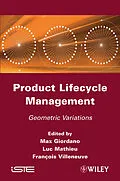This book gives a comprehensive view of the most recent major
international research in the field of tolerancing, and is an
excellent resource for anyone interested in Computer Aided
Tolerating.
It is organized into 4 parts. Part 1 focuses on the more general
problems of tolerance analysis and synthesis, for tolerancing in
mechanical design and manufacturing processes. Part 2 specifically
highlights the simulation of assembly with defects, and the
influence of tolerances on the quality of the assembly. Part 3
deals with measurement aspects, and quality control throughout the
life cycle. Different measurement technologies and methods for
estimating uncertainty are considered. In Part 4, different aspects
of tolerancing and their interactions are explored, from the
definition of functional requirement to measurement processes in a
PLM approach.
Autorentext
Max Giordano is emeritus professor at the University of Savoy France. His research interests include geometry modeling, computer-aided design and computer-aided tolerancing, and he developed the concept of "domain" for the 3-D tolerance analyses and synthesis.
François Villeneuve is Professor at the University of Grenoble (France) and vice-director of the G-SCOP research laboratory. His research interests include Computer Aided Process Planning (CAPP), Knowledge Management, Product Design and Tolerancing. In Tolerancing, he is developing a 3D geometrical model for product defects through the product life cycle.
Luc Mathieu is Professor at the University of Paris-Sud 11, in the Department of Production Engineering (France). He is Director of the Automated Production Research Laboratory (LURPA) in the Ecole Normale Supérieure de Cachan (France). He is also a fellow member of CIRP (International Academy of Production Engineering). His research interests include geometry, computer-aided tolerancing, coordinates metrology and digital production engineering.
Zusammenfassung
This book gives a comprehensive view of the most recent major international research in the field of tolerancing, and is an excellent resource for anyone interested in Computer Aided Tolerating.
It is organized into 4 parts. Part 1 focuses on the more general problems of tolerance analysis and synthesis, for tolerancing in mechanical design and manufacturing processes. Part 2 specifically highlights the simulation of assembly with defects, and the influence of tolerances on the quality of the assembly. Part 3 deals with measurement aspects, and quality control throughout the life cycle. Different measurement technologies and methods for estimating uncertainty are considered. In Part 4, different aspects of tolerancing and their interactions are explored, from the definition of functional requirement to measurement processes in a PLM approach.
Inhalt
Preface xix
PART I. TOLERANCE ANALYSIS AND SYNTHESIS 1
Chapter 1. A New Method of Expressing Functional Requirements and How to Allocate Tolerance to Parts 3
Pierre-Antoine ADRAGNA and Pascal HERNANDEZ
Chapter 2. A Parametric Approach to Determine Minimum Clearance in Overconstrained Mechanisms 21
Philippe SERRE, Faida M'HENNI and Andre CLEMENT
Chapter 3. Quick GPS: Tolerancing of an Isolated Part 39
Robin CHAVANNE and Bernard ANSELMETTI
Chapter 4. Synthesis and Statistical Analysis for 3D Tolerancing 59
Max GIORDANO, Pascal HERNANDEZ and Dimitri DENIMAL
Chapter 5. Reliability Analysis of the Functional Specification Applied to a Helicopter Gas Turbine 77
Yann LEDOUX, Denis TEISSANDIER and Samir SID-AHMED
Chapter 6. Inertial Tolerancing According to ISO GPS 99
Dimitri DENIMAL, Max GIORDANO, Maurice PILLET and Alain SERGENT
Chapter 7. Tolerance Analysis based on Quantified Constraint Satisfaction Problems 125
Ahmed Jawad QURESHI, Jean-Yves DANTAN, Jerome BRUYERE and Regis BIGOT
Chapter 8. Tolerance Analysis in Manufacturing Using the MMP, Comparison and Evaluation of Three Different Approaches 145
Mojtaba KAMALI NEJAD, Frederic VIGNAT and Francois VILLENEUVE
PART II. SIMULATION OF ASSEMBLIES 173
Chapter 9. A Chronological Framework for Virtual Sheet Metal Assembly Design 175
Johan SEGEBORN, Anders CARLSSON, Johan S. CARLSON and Rikard SODERBERG
Chapter 10. A Method to Optimize Geometric Quality and Motion Feasibility of Assembly Sequences 191
Domenico SPENSIERI, Johan S. CARLSON, Lars LINDKVIST, Robert BOHLIN and Rikard SODERBERG
Chapter 11. Modeling and Simulation of Assembly Constraints in Tolerance Analysis of Rigid Part Assemblies 209
Pasquale FRANCIOSA, Salvatore GERBINO and Stanislao PATALANO
Chapter 12. Tolerance Analysis with detailed Part Modeling 231
Tobias STOLL, Stefan WITTMANN and Harald MEERKAMM
Chapter 13. Assembly Method Comparison Including Form Defect 245
Stephane MORIERE, Jean MAILHE, Jean-Marc LINARES and Jean-Michel SPRAUEL
Chapter 14. Influence of Geometric Defects on Service Life 259
Laurent ZAMPONI, Emmanuel MERMOZ, Jean-Marc LINARES and Jean-Michel SPRAUEL
Chapter 15. GapSpace Multi-dimensional Assembly Analysis 273
Edward MORSE and Xiaobin YOU
PART III. MEASUREMENT 299
Chapter 16. Impact of the Sampling Strategy on Geometrical Checking Uncertainties 301
Jean MAILHE, Jean-Marc LINARES, Jean-Michel SPRAUEL and Jean-Paul RAYNAL
Chapter 17. Predetermination of Measurement Uncertainty in the Application of Computed Tomography 317
Albert WECKENMANN and Philipp KRAMER
Chapter 18. Application of Function Oriented Parameters for Areal Measurements in Surface Engineering 331
Albert WECKENMANN and Ozgur TAN
Chapter 19. Validation of a Reception or Production Control Process by the Inertial Indicator IG 345
Daniel DURET, Maurice PILLET, Alain SERGENT and Dimitri DENIMAL
Chapter 20. Detection of Areas with Critically Reduced Thickness of Formed Sheet Metal Parts Using Two Oppositely Positioned Fringe Projection Systems 355
Albert WECKENMANN and Natasa PETROVIC
Chapter 21. Variability of the Manufacturing Process in the GPS Framework: A Case Study 371
Manuela DE MADDIS and Martina GANDINI
Chapter 22. Virtual CMM-based Sampling Strategy Optimization 385
Giovanni MORONI and Stefano PETRO
Chapter 23. Impact of Workpiece Shape Deviations in Coordinate Metrology...
